Batch #003 - Old Ale Brew Day!
Saturday was the best day of the week again for us here at Tres Perros. . . BREW DAY! This time around, we are attempting and Old Ale/Stock Ale variety. It is actually an approximation of a clone of a rather popular brand of British old Ale that is rumored to not be distributed in the United States any more. The brew being cloned must stay a secret for now, (well its not really much of a secret if you do a bit of research) but eventually that fact will be revealed. But that's not important right now, what is, was that it was BEER MAKING TIME!
(Note: If anybody is interested in homebrewing, but hasnt taken the plunge yet, the following post is a pretty simple breakdown of how to make an Extract Based Brew. Its pretty simple, if you just take your time and think things through).
The first thing we did was get everything together. I am a rather scatterbrained type of guy and it really makes life easier if I keep all the materials I need to do something in close contact. The french call this mis en plas (literally "put in place"), and in cooking as well as brewing, its a good tenet to follow.: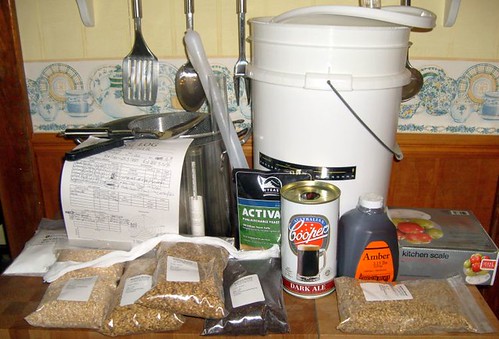
First you get together all the things you need for the boil, and then you gather everything that needs to be sanitized and do as such. Sanitation cannot be overstressed. While you are trying to grow yeast in an effort to get them to make beer for you, thats the only thing you want growing: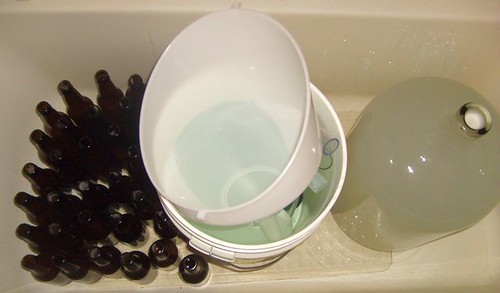
Next we weighed out all the specialty grains out to steep. Specialty grains are used by homebrewers to add color, body, taste, and aromatic properties to the beer. In fact, some styles of beer cannot be properly achieved without the help of specialty grains.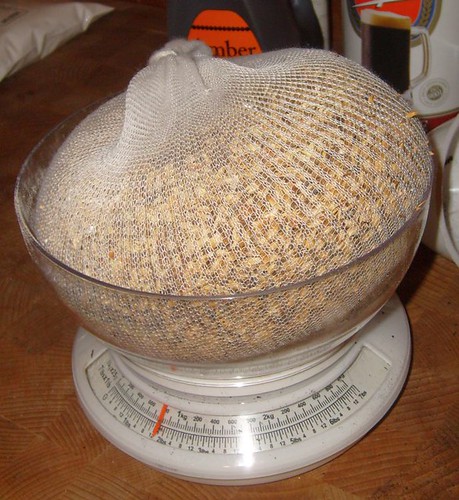
When steeping specialty grains for for an extract brew, you generally need the water between 150-170 degrees, for aat least thirty minutes. The process is much, like making a pot of grain tea: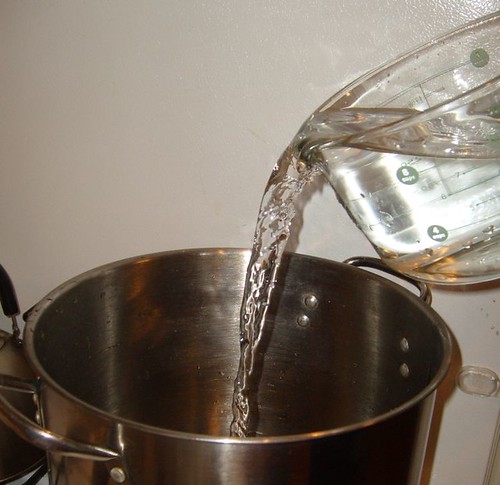
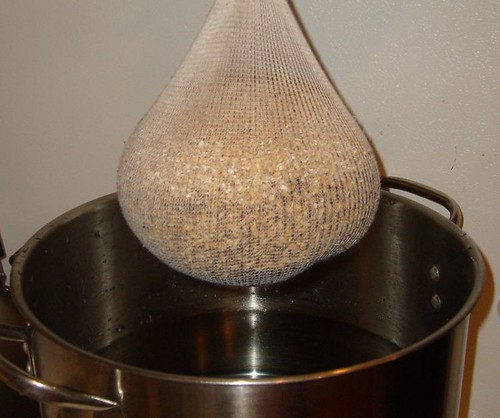
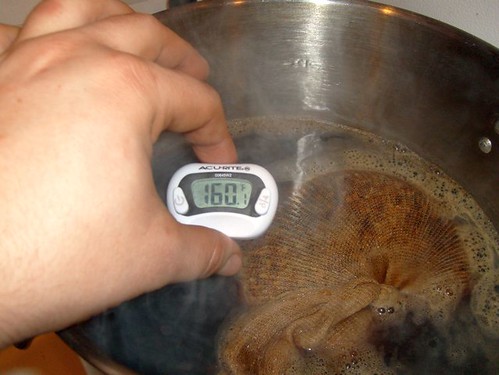

Our recipe called for a rinse at the end of the steeping cycle. In another pot we had more water heated to 175 degrees, which we ran through the sack of grain to get all the goodness out: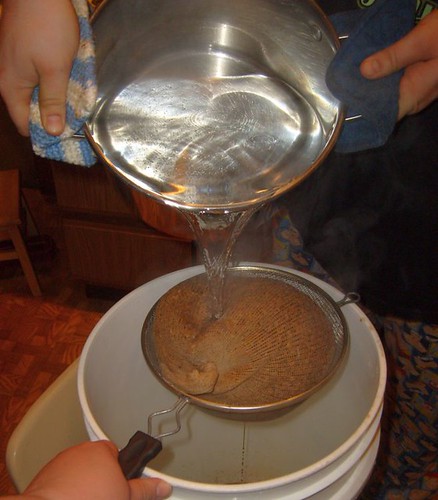
When thoroughly rinsed out, you pour all the water back int he pot and bring it to a boil. When the boil is good and rolling, there are Malt and Hop Pellet additions to be made at regular intervals. In our recipe the boil lasted for a full hour: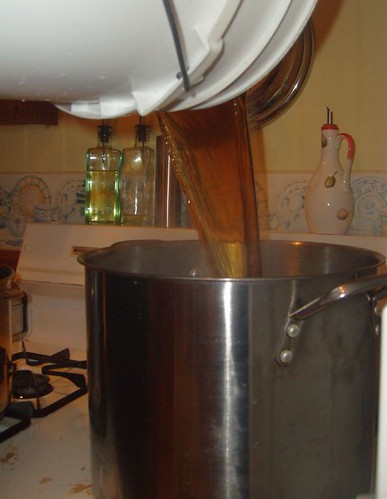
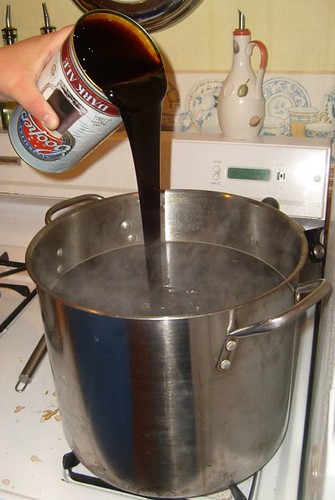
(Our Old Ale recipe included a can of Coopers Dark Ale extract. This can be used to make a pretty decent beer on its own, but with a little tweaking seems to make a decent base to build upon, for a good beer. We added it into the pot at the very beginning of the 60 min boil).
(In all the brews I have made to date, I have used hop pellets, as they seem to be the most convenient to use and store. In this case, Willamette hops are added for bittering at the 45 minute mark).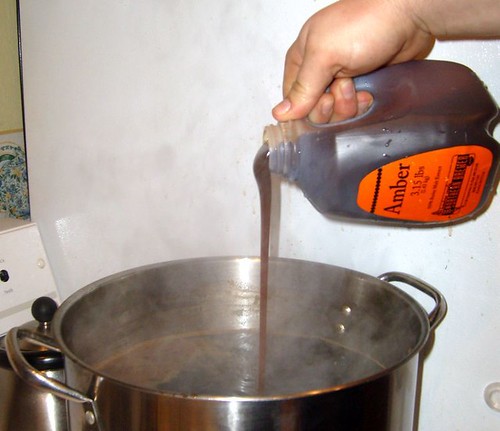
In batches of beer that boil a volume smaller than the total volume, it can be beneficial to only add some of the malt extract at the beginning of the boil. Adding some of the malt toward the end of the boil accomplishes a few things. First, because the malt spends less time over the burner its less likely to scorch or discolor. also, there is some evidence to suggest it helps you utilize hops more efficiently. We added the unhopped amber extract with 15 minutes remaining in the boil. 
A quick addition of Perle Hops with 2 minutes to go and the boil is done!
All thats left is to strain and cool the wort, add some yeast, and you are ready to go!
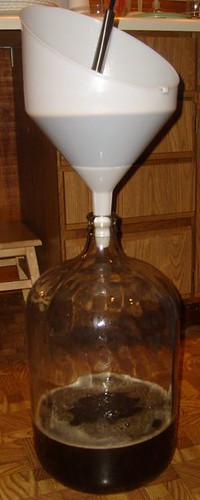
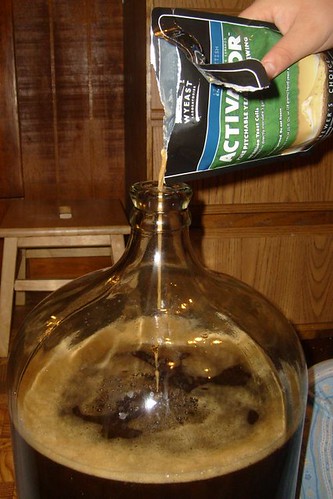
Now, as usual, the tough part. The waiting. . .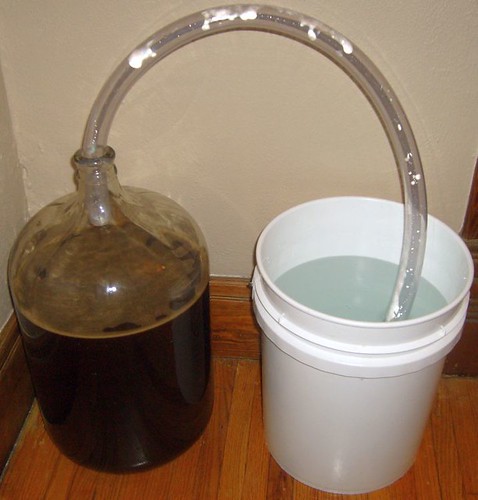

6 comments:
Just a few newbie-researching questions:
After straining the wort into the bucket, did you let it cool completely in the bucket or did you transfer the wort into the carboy, wait for it to cool, and then add the yeast?
What benefits/tradeoffs are there to using that interesting tube set-up while the whole thing ferments?
And, did you re-sanitize the bucket between the initial boil, second screening, and in the fermenting stage?
Yes when we strained into the bucket before putting in the Carboy, and that bucket had the other two gallons of very cold water we needed to get our batch up to total volume. So yes, I let it cool most of the way in the bucket, because glass can be touchy, and I dont even want to risk the slightest chance of breaking.
With carboys, using the blowoff tube (the setup I have pictured) has two purposes:
1) The larger tube means more CO2 can escape the tube (through the bucket of sanitized water) versus a regular airlock, which minimizes pressure buildup in the carboy.
2) In scenarios where the yeast get really active, you have a clean area setup for bubble over to go (through the tube, into the sanitizer), as opposed to blowing the lid off a bucket or cork from a carboy.
And yes, we re-sanitized the bucket during the wort boil.
;-)
Thanks for the great response.
Here's another question:
Is the bucket used throughout also the bottling bucket? Is the spigot contraption delicate in any way that would discourage its use in any other manner than the last, bottling step?
In my case, no, it is not the bottling bucket, I just got as white food grade bucket from work (which is easy, i work in a candy factory). A lot of people start homebrewing in plastic buckets, so those fermenters would do. As long as you were careful with the bottling spout, I am sure it would work fine.
"What is captcha code?, pls provide me captcha code codes or plugin, Thanks upfront."
--------------------------------------------
my website is
http://dogshirt.org
Also welcome you!
You manufactured some very good factors there. I believe a research about the topic and discovered most people today will concur withyour weblog.
--------------------------------------------
my website is
http://stoppingsmoking.us
Also welcome you!
Post a Comment